watch size guide wrist male
Proper watch sizing is crucial for men’s comfort and style. With average wrist sizes around 18.42 cm‚ watches typically range from 38mm to 46mm‚ ensuring a perfect fit for every wrist.
1.1 Importance of Proper Watch Fit
A proper watch fit is essential for both comfort and aesthetics. A watch that is too tight can cause discomfort‚ while one that is too loose may appear unflattering. The right fit ensures the watch sits comfortably on the wrist‚ enhancing the overall wearing experience. Proper sizing also impacts the watch’s functionality‚ as a well-fitted timepiece is easier to read and use. Additionally‚ the correct fit contributes to the watch’s visual appeal‚ making it a seamless accessory that complements personal style. Balancing style and comfort is key to enjoying your watch daily.
1.2 Understanding Wrist and Watch Measurements
Understanding wrist and watch measurements is vital for selecting the perfect timepiece. Male wrist sizes typically range from 165mm to 205mm‚ with an average of 184.2mm. Watches are measured by case diameter‚ ranging from 38mm to 46mm for men. A 42mm watch is the most popular choice‚ balancing style and comfort. Proper measurement ensures the watch fits securely without being too tight or loose. Accurate sizing enhances comfort‚ functionality‚ and aesthetic appeal‚ making it essential for everyday wear. Always consider both wrist circumference and watch dimensions for the ideal fit.
Average Male Wrist Sizes
The average male wrist size is approximately 18.42 cm (184.2mm)‚ typically ranging from 165mm to 205mm‚ ensuring watches between 38mm and 46mm fit comfortably on most wrists.
2.1 Global Averages for Male Wrist Circumference
The average male wrist circumference is approximately 18.42 cm (184.2mm)‚ with most men falling between 165mm and 205mm. This range helps determine the ideal watch size‚ ensuring comfort and style. Global averages vary slightly based on factors like nationality‚ lifestyle‚ and body type. For instance‚ men with larger builds or those who are active often have wider wrists‚ while smaller-framed individuals may have narrower measurements. Understanding these averages is key to selecting a watch that complements your wrist size‚ ensuring a balanced and proportional look.
2.2 Variations in Wrist Sizes Across Different Body Types
Wrist sizes vary significantly across different body types. Larger‚ more muscular men often have wrists exceeding 190mm‚ while smaller or petite individuals may have wrists under 170mm. Active individuals‚ such as athletes‚ tend to have broader wrists due to muscle development. Conversely‚ those with slimmer builds or less physical activity typically have narrower wrists; Understanding these variations helps in selecting a watch that proportionally fits your wrist‚ ensuring both comfort and aesthetics. This range highlights the importance of measuring your wrist accurately to find the most suitable watch size.
How to Measure Your Wrist
To measure your wrist‚ use a flexible tape measure or a string. Wrap it snugly around the narrowest part of your wrist‚ then note the circumference.
3.1 Using a Flexible Tape Measure
Measuring your wrist with a flexible tape measure is the most accurate method. Wrap the tape snugly around the narrowest part of your wrist‚ just above the wrist bone; Ensure the tape is level and not too tight or loose. For men‚ the average wrist size is approximately 18.42 cm (7.5 inches)‚ but sizes can range from 16.5 cm to 20.5 cm. This measurement will help determine the ideal watch size‚ typically between 38mm and 46mm for men‚ with 42mm being the most popular choice for a balanced fit.
3.2 Alternatives to a Tape Measure
If you don’t have a flexible tape measure‚ you can use a string or a ruler to measure your wrist. Wrap the string around your wrist at the narrowest point‚ mark the overlap with a pen‚ and then measure the length with a ruler. Alternatively‚ you can use a printable wrist measurement guide‚ which can be found online. These guides provide a scaled template that you can wrap around your wrist to determine your size accurately. Ensure the fit is snug but not tight for the best results. This method is convenient and nearly as accurate as using a tape measure.
3.3 Printable Wrist Measurement Guide
A printable wrist measurement guide is a convenient tool for determining your wrist size. Simply print the template on DIN A4 paper in horizontal format‚ ensuring the scale is accurate. Wrap the guide around your wrist at the narrowest point‚ adjusting until it fits snugly but not tightly. This method provides a clear indication of your wrist size‚ helping you choose the perfect watch band or strap. Many online resources offer these guides‚ making it easy to find one that suits your needs. This approach is especially useful if you don’t have a tape measure handy.
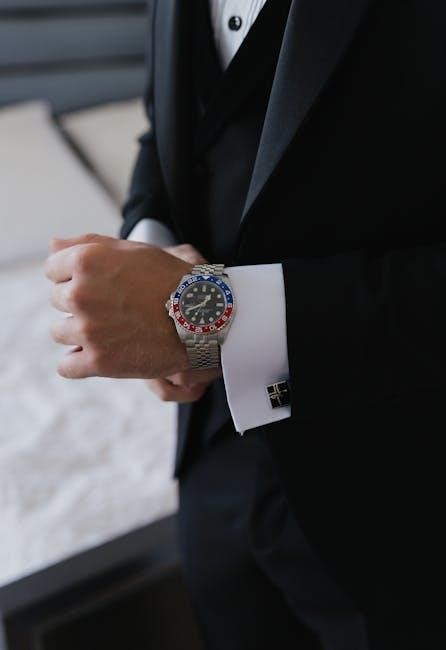
Watch Case Diameter Guide
Watch case diameters for men typically range from 38mm to 46mm‚ with 42mm being the most popular size‚ complementing the average male wrist size of 18.42cm.
4.1 Understanding Watch Case Sizes (38mm to 46mm)
Men’s watch case sizes generally range from 38mm to 46mm in diameter. The 42mm size is the most popular‚ fitting the average male wrist of 18.42cm. Smaller cases (38-40mm) suit slimmer wrists‚ while larger cases (44-46mm) complement bigger wrists. The case size significantly impacts comfort and aesthetics‚ ensuring the watch neither overwhelms nor appears too small. Proper sizing ensures a balanced look‚ with sizes beyond 46mm often appearing overly large. This range offers versatility‚ catering to various wrist sizes and personal preferences‚ making it essential to choose a size that aligns with individual measurements for the perfect fit.
4.2 Small Watches (38mm to 40mm)
Small watches‚ ranging from 38mm to 40mm‚ are ideal for men with slimmer wrists‚ typically under 7 inches in circumference. These sizes offer a sleek‚ elegant appearance without overwhelming the wrist. The 38mm to 40mm range is perfect for those preferring a more subtle timepiece‚ ensuring comfort and a refined aesthetic. While smaller in diameter‚ these watches maintain a sophisticated look‚ making them suitable for both formal and casual settings. They are a great choice for individuals with narrower wrists‚ providing a balanced and proportional fit that enhances personal style without compromising functionality.
4.3 Medium Watches (41mm to 43mm)
Medium watches‚ ranging from 41mm to 43mm‚ are a versatile choice for men with average wrist sizes‚ typically between 7 and 7.5 inches. This size strikes a perfect balance‚ offering a prominent yet understated presence. The 41mm to 43mm range is ideal for those seeking a timepiece that complements both casual and formal attire. These watches are neither too small nor too large‚ making them suitable for a wide range of wrist sizes and personal styles. Their proportions ensure comfort while maintaining a modern‚ sophisticated aesthetic‚ making them a popular choice for everyday wear.
4.4 Large Watches (44mm to 46mm)
Larger watches‚ measuring between 44mm and 46mm‚ are ideal for men with bigger wrists‚ typically above 7.5 inches. These timepieces make a bold statement while remaining stylish. The 44mm to 46mm range is popular for sporty or statement pieces‚ offering a robust yet balanced appearance. They are often preferred by those with broader wrists or a preference for a more imposing design. While larger than average‚ these watches avoid appearing overly bulky‚ ensuring a comfortable and visually appealing fit for larger wrist sizes. This range is perfect for confident individuals seeking a striking accessory that complements their physique and personal style.
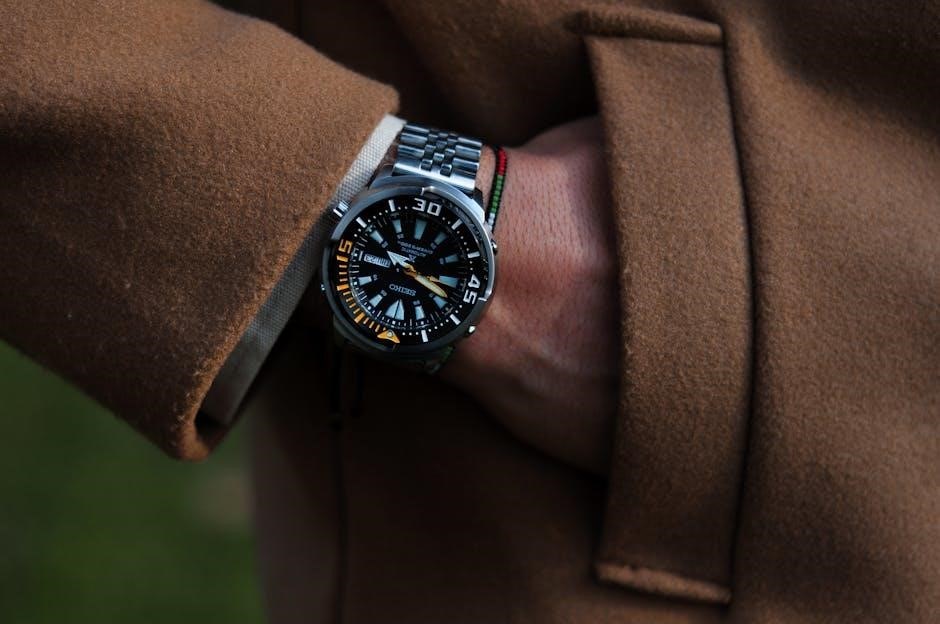
Band and Strap Size Guide
Proper band and strap sizing ensures optimal comfort and style. Measure your wrist circumference to select the ideal band size‚ ensuring a secure and comfortable fit.
5.1 Measuring Your Wrist for the Perfect Band Fit
To ensure a perfect band fit‚ accurately measure your wrist using a flexible tape measure. Wrap it snugly around the narrowest part of your wrist‚ typically just above the wrist bone. Note the circumference in millimeters or inches. For men‚ average wrist sizes range from 165mm to 205mm. Use this measurement to select a band size that matches your wrist dimensions. If a tape measure isn’t available‚ printable wrist measurement guides can provide an accurate alternative. Proper measurement ensures the watch sits comfortably‚ neither too tight nor too loose‚ enhancing both style and comfort.
5.2 Common Band Sizes for Men
Common band sizes for men typically range from 165mm to 205mm‚ corresponding to average wrist circumferences. Standard sizes include 180mm‚ 190mm‚ and 200mm‚ catering to most wrist sizes. Smaller wrists (165-185mm) often fit 180mm bands‚ while larger wrists (190-205mm) suit 200mm bands. Some watches offer adjustable straps for universal fit. Band sizes can vary by brand‚ so checking specific manufacturer guides is recommended. Ensure the band aligns with your wrist measurement for optimal comfort and style‚ as ill-fitting bands can compromise both aesthetics and wearability.
5.3 Adjusting Watch Bands for Comfort
Adjusting watch bands is key to ensuring a comfortable fit. Many bands feature removable links or adjustable straps‚ allowing customization to your wrist size. For metal bands‚ use a tool to remove excess links‚ while leather straps often have buckles or holes for precise adjustment. Some watches include quick-release mechanisms for easy resizing. Proper adjustment ensures the watch sits snugly without being too tight or loose. Experiment with different settings to find your ideal fit‚ ensuring comfort throughout the day; A well-adjusted band enhances both style and wearability‚ making your watch a seamless accessory.
Popular Watch Sizes for Men
Men’s watches typically range from 38mm to 46mm‚ with 42mm being the most popular choice‚ offering a balanced fit for average wrist sizes of 18.42cm.
6.1 The 42mm Watch: The Most Popular Choice
The 42mm watch is the most popular choice for men‚ perfectly balancing style and comfort. It suits average wrist sizes of 18.42cm‚ offering a versatile fit for various lifestyles. This size is neither too bulky nor too small‚ making it ideal for both casual and formal wear. Many manufacturers recommend 42mm as it complements most wrist circumferences‚ ensuring a comfortable and elegant look. Its timeless appeal makes it a favorite among watch enthusiasts‚ blending seamlessly with different personal styles and preferences.
6.2 40mm Watches: A Balance Between Size and Comfort
The 40mm watch strikes a perfect balance between size and comfort‚ making it a versatile choice for men. It is particularly recommended for wrists smaller than 7 inches‚ ensuring a sleek‚ proportional fit. This size is ideal for those who prefer a slightly more understated design without sacrificing style. The 40mm watch is popular for its balanced look‚ offering comfort and elegance for everyday wear. It is a great option for men with average to smaller wrist sizes‚ blending seamlessly into both casual and formal settings while maintaining a sophisticated appeal.
6.3 45mm Watches: For Larger Wrists
The 45mm watch is designed for men with larger wrists‚ typically those measuring over 7.5 inches or 190mm in circumference. This size offers a bold yet balanced appearance‚ complementing broader wrist sizes without feeling overly bulky. Ideal for those who prefer a substantial timepiece‚ the 45mm watch strikes a harmony between style and comfort. It is particularly suited for active individuals or those with a robust build‚ ensuring a confident and elegant look. While larger than average‚ it remains within the standard range for men’s watches‚ making it a practical choice for everyday wear.
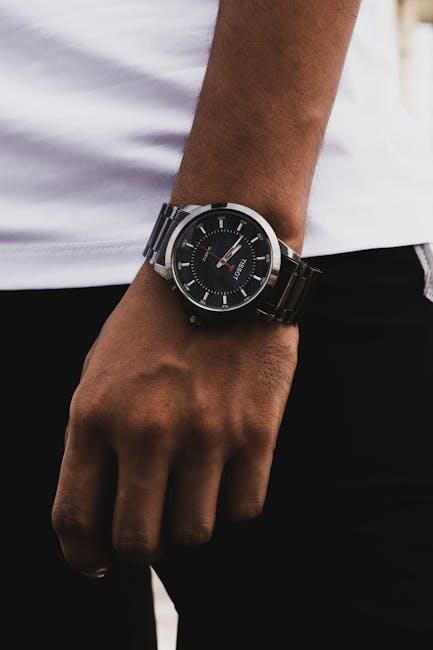
How to Choose the Right Watch Size
Choosing the right watch size combines wrist measurement‚ lifestyle‚ and personal style. Average male wrists are 18.42cm‚ with watches ranging from 38mm to 46mm‚ 42mm being the most popular choice.
7.1 Considering Your Wrist Circumference
Measuring your wrist circumference is the first step in selecting the right watch size. The average male wrist size is approximately 18.42 cm‚ with most men’s watches ranging from 38mm to 46mm. For smaller wrists (below 17 cm)‚ a 38mm to 40mm watch is ideal‚ while larger wrists (above 19 cm) suit 44mm to 46mm cases. Ensure the watch isn’t too tight or loose; it should fit comfortably. Using a flexible tape measure or a printable guide can help determine your size accurately‚ ensuring the watch complements your wrist proportions effortlessly;
7.2 Matching Watch Size to Your Lifestyle
Choosing a watch size that aligns with your lifestyle ensures both functionality and style. For active individuals or those with outdoor pursuits‚ larger watches (44mm-46mm) are practical and durable. Conversely‚ smaller watches (38mm-40mm) are ideal for formal events or office settings. Everyday wear often favors medium sizes (41mm-43mm) for versatility. Consider whether your activities require a robust build or a sleek design. Personal preferences and wardrobe also play a role. By matching your watch size to your lifestyle‚ you ensure the timepiece is both functional and stylish‚ adapting seamlessly to your daily routines and special occasions.
7.3 Aesthetics: Watch Size and Personal Style
Watch size significantly impacts personal style and aesthetics. A watch that complements your wrist size creates balance and harmony. Smaller watches (38mm-40mm) are sleek and elegant‚ suiting formal attire‚ while larger watches (44mm-46mm) make a bold statement‚ often preferred for casual or sporty looks. Medium sizes (41mm-43mm) offer versatility‚ blending with most styles. Proportions matter; oversized watches can overwhelm slender wrists‚ while petite styles may appear lost on larger wrists. Consider your wardrobe and personal taste to ensure the watch enhances your overall look‚ striking the perfect balance between functionality and fashion.
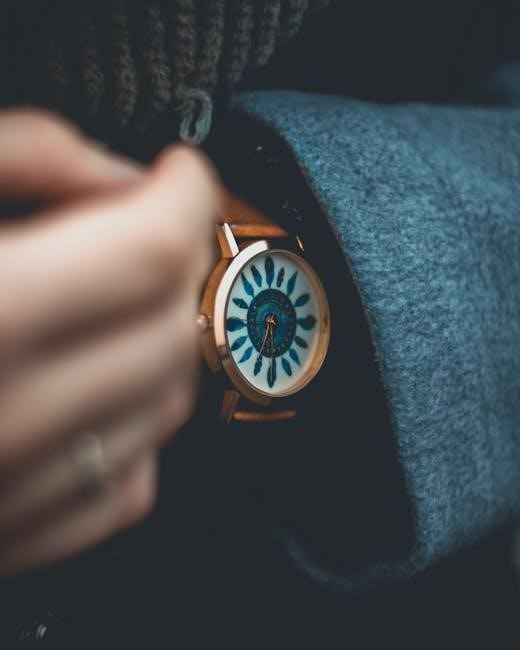
Watch Thickness and Lug Width
Watch thickness ranges from 10mm to 15mm‚ with 12-14mm being common for men. Lug width‚ typically 20mm to 24mm‚ impacts comfort and how the watch sits on the wrist.
8.1 Understanding Watch Thickness Measurements
Watch thickness is measured from the base to the top of the case‚ typically ranging from 10mm to 15mm for men’s watches. A thinner profile‚ around 12mm‚ offers a sleek‚ elegant look‚ while thicker watches (14mm-15mm) often appeal to those preferring a robust‚ sporty design. The thickness impacts both comfort and aesthetic appeal‚ with slimmer models suiting formal wear and thicker ones being ideal for sports or casual styles. Balancing thickness with wrist size ensures a harmonious fit‚ enhancing both functionality and personal style.
8.2 Lug Width and Its Impact on Fit
Lug width‚ the distance between the watch’s lugs‚ significantly affects how the timepiece sits on the wrist. Proper lug width ensures the strap or band fits securely‚ preventing the watch from shifting or feeling too tight. For men‚ lug widths typically range from 20mm to 24mm‚ with 22mm being the most common. A lug width that matches your wrist size ensures the watch looks proportionate and feels comfortable. Incorrect lug width can lead to an ill-fitting watch‚ making it either too loose or overly restrictive. Measuring lug width alongside wrist size ensures a seamless fit for any style or occasion.
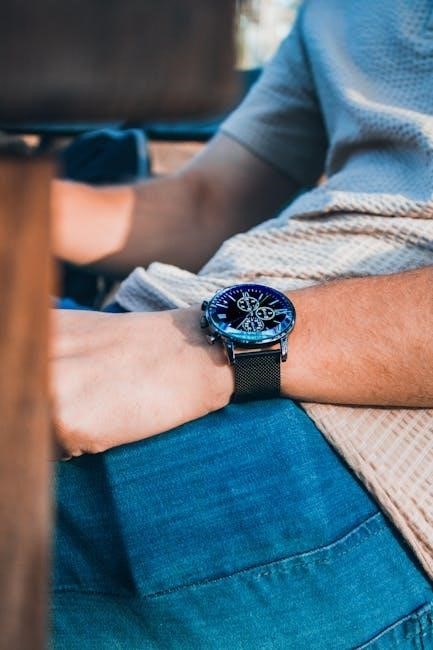
Watch Size vs. Wrist Size Chart
A watch size vs. wrist size chart helps men determine the ideal timepiece by matching case diameter to wrist circumference‚ ensuring a balanced and comfortable fit.
9.1 Creating a Personalized Size Chart
A personalized size chart is tailored to your wrist measurements‚ ensuring the perfect fit. Measure your wrist using a flexible tape measure or printable guide. Note your circumference in millimeters. Match this to watch case diameters (38mm-46mm). For example‚ a 7-inch (178mm) wrist suits a 40mm watch‚ while a 7.5-inch (190mm) wrist fits a 42mm or 45mm case. Create a table correlating wrist sizes with recommended diameters. Include popular sizes like 38mm‚ 40mm‚ 42mm‚ and 45mm. Use this chart to choose watches confidently‚ ensuring comfort and style. Print or save it for future reference when selecting timepieces.
9.2 Using Manufacturer Size Guides
Manufacturer size guides simplify watch selection by providing tailored recommendations. Many brands‚ like Apple and Samsung‚ offer printable templates or digital tools to measure your wrist. These guides often include charts correlating wrist circumference with watch case diameters. For instance‚ Apple’s guide helps determine the ideal size for their watches‚ ensuring a precise fit. Similarly‚ some brands provide specific sizing recommendations based on their models. Using these resources ensures compatibility and comfort‚ making the selection process more accurate and personalized. Always check the manufacturer’s guidelines for the best fit‚ especially for brands with unique sizing systems.
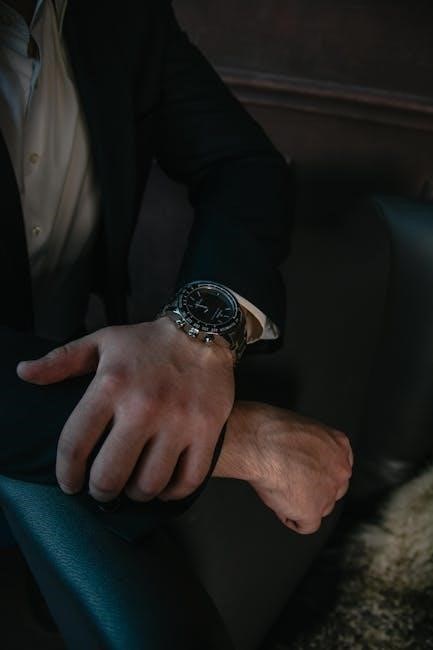
Common Mistakes When Choosing a Watch Size
Ignoring wrist measurements and prioritizing trends over comfort are common errors. Ensure proper fit by measuring accurately and selecting sizes that align with your lifestyle and style preferences.
10.1 Ignoring Wrist Measurement
One of the most frequent mistakes men make is neglecting to measure their wrist before choosing a watch. This oversight often results in watches that are either too tight or too loose‚ compromising both comfort and style. Proper wrist measurement ensures a balanced fit‚ preventing the watch from sliding excessively or digging into the skin. With average male wrist sizes around 18.42 cm‚ using a tape measure or online tools can provide accurate sizing. Ignoring this step risks poor fit and discomfort‚ making it essential to prioritize measurement for the best results.
10.2 Prioritizing Trends Over Comfort
Choosing a watch based solely on current trends often leads to poor fit and discomfort. While larger watches may be fashionable‚ they can overwhelm smaller wrists‚ appearing disproportionate. Conversely‚ overly small watches on larger wrists may look out of place. Ignoring personal comfort for style can result in a watch that is too tight or too loose‚ affecting its practicality. Men’s watches typically range from 38mm to 46mm‚ with 42mm being the most popular. Prioritizing trends over comfort can lead to dissatisfaction‚ making it essential to balance style with individual wrist measurements and lifestyle needs for long-term satisfaction.
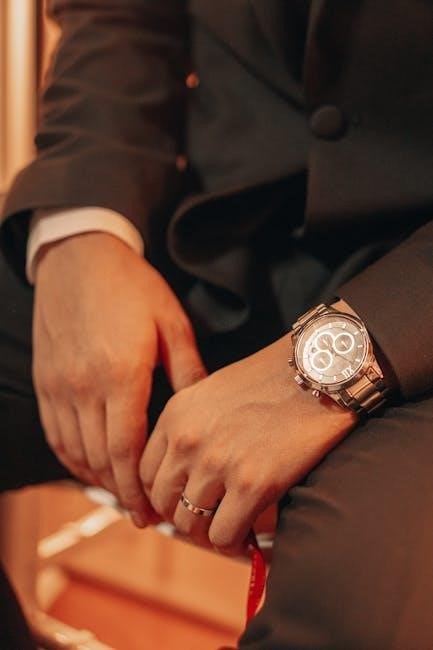
The Role of Watch Brands in Sizing
Watch brands often provide size recommendations‚ with popular men’s watches ranging from 38mm to 46mm‚ and tools like printable templates to help men find their perfect fit.
11.1 Brand-Specific Size Recommendations
Watch brands often tailor their size recommendations to cater to diverse wrist measurements. For instance‚ Rolex typically offers watches between 40mm to 41mm for men‚ while Omega suggests sizes ranging from 38mm to 45mm. Apple Watches feature adaptive sizing‚ with models like the 45mm fitting larger wrists. Many brands provide tools like printable templates or online calculators to help men determine their ideal watch size. These resources ensure a personalized fit‚ enhancing both comfort and aesthetics. By considering brand-specific guidelines‚ men can make informed decisions when selecting a timepiece that complements their wrist size and personal style.
11.2 Popular Brands and Their Typical Sizes
Popular watch brands cater to men’s wrist sizes with tailored sizing options. For example‚ Rolex typically offers men’s watches in 40mm to 41mm diameters‚ while Omega ranges from 38mm to 45mm. Breitling often features larger sizes‚ up to 46mm‚ ideal for bigger wrists. Apple Watches include a 45mm option for larger wrists‚ while brands like Seiko and Citizen offer versatile sizes between 38mm and 43mm. These brands ensure their designs complement various wrist sizes‚ providing a comfortable and stylish fit for men seeking the perfect timepiece.
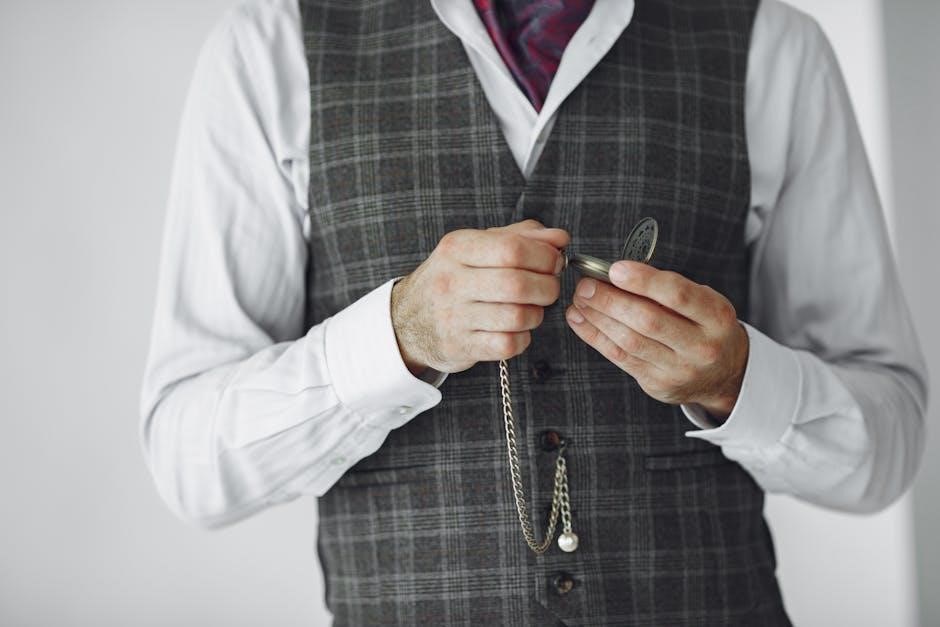
How to Use a Watch Size Guide
Use a printable size guide or online tools to determine your ideal watch size. Wrap the tool around your wrist to find the perfect fit instantly.
12.1 Printing and Using a Size Template
Print a watch size template on DIN A4 paper in horizontal format. Cut it out and wrap it around your wrist to measure. Align the template with your wristbone for accuracy. The template will indicate your ideal watch size based on how it fits. This method ensures a perfect fit without guessing. Use the markings to determine the best watch diameter for your wrist size. Simply compare the template’s measurements to the watch size chart provided. This step-by-step process makes selecting the right watch size easy and precise‚ ensuring comfort and style.
12.2 Online Tools for Watch Size Calculation
Online tools simplify watch size calculation by allowing users to input their wrist measurements and receive recommendations. Many watch brands offer digital size guides on their websites‚ enabling precise calculations; Some tools use interactive features to visualize how a watch will fit on your wrist. By entering your wrist circumference‚ these tools provide a recommended case diameter and band size. They often include comparison charts and visual aids to ensure accuracy. These resources are especially useful for those shopping online‚ offering convenience and eliminating guesswork. They help users find the perfect fit without physical measurements‚ making watch selection easier than ever.
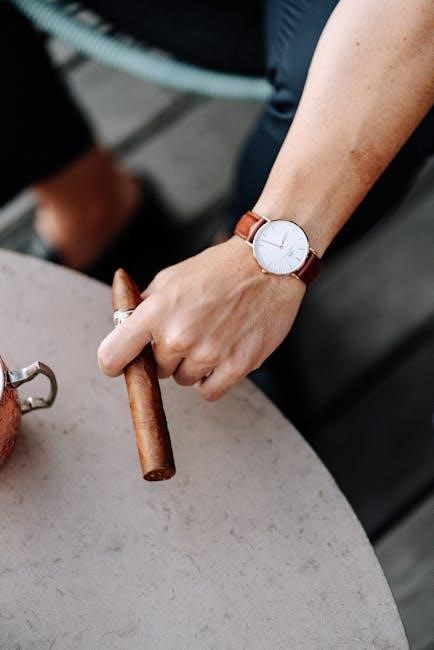
The Future of Watch Sizing
Future watch sizing may feature automatic wrist measurement technology‚ like Apple’s patented touchless system. Smartwatches could adapt to wrist sizes dynamically‚ ensuring a perfect fit without manual adjustments.
13.1 Automatic Wrist Measurement Technology
Innovations like Apple’s patented touchless wrist measurement system are revolutionizing watch sizing. This technology uses sensors to automatically detect wrist circumference‚ eliminating the need for manual measuring tools. Such advancements promise greater accuracy and convenience‚ especially for smartwatches. By integrating these features‚ future devices could adapt to individual wrist sizes dynamically‚ ensuring optimal comfort and fit. This technology is particularly beneficial for active individuals‚ such as athletes‚ who need watches that perform seamlessly without compromising on size or comfort. Automatic sizing could also enhance the shopping experience‚ allowing users to find the perfect watch size effortlessly.
13.2 Smartwatches and Adaptive Sizing
Smartwatches are embracing adaptive sizing to enhance user experience. By integrating automatic wrist measurement technology‚ these devices can dynamically adjust settings based on individual wrist sizes. This innovation ensures optimal comfort and performance‚ particularly for athletes and active users. Adaptive sizing also simplifies the process of finding the right watch size‚ allowing users to enjoy a seamless fit without manual adjustments. As smartwatches evolve‚ such features are expected to become standard‚ offering unparalleled convenience and personalization for men with varying wrist sizes and lifestyles.
Choosing the right watch size is a balance of comfort‚ style‚ and functionality. By considering wrist size and lifestyle‚ men can find a timepiece that perfectly complements their look and needs‚ ensuring a confident and practical choice that enhances daily wear.
14.1 Final Tips for Choosing the Perfect Watch Size
When selecting a watch‚ prioritize both comfort and personal style. Measure your wrist accurately and consider your lifestyle—sporty designs for active men‚ or sleek options for formal wear. Popular sizes like 42mm and 45mm cater to most wrist sizes‚ but ensure the thickness complements your build. Adjustable bands offer versatility‚ while fixed sizes require precise measurement. Experiment with different styles to find your ideal fit‚ and don’t hesitate to use online tools or in-store trials to ensure the watch feels right on your wrist.
14.2 Encouragement to Experiment and Find the Right Fit
Experimenting with different watch sizes and styles is key to finding your perfect fit. Don’t hesitate to try on various options‚ as comfort and aesthetics are deeply personal. Whether you prefer classic elegance or sporty designs‚ there’s a watch to suit your taste. Use online size guides or printable templates to narrow down your choices‚ and don’t be afraid to seek advice from experts. Remember‚ the right watch should feel natural on your wrist‚ balancing style with functionality. Take your time to explore—your effort will pay off when you find the ideal timepiece that complements your unique style and wrist size.